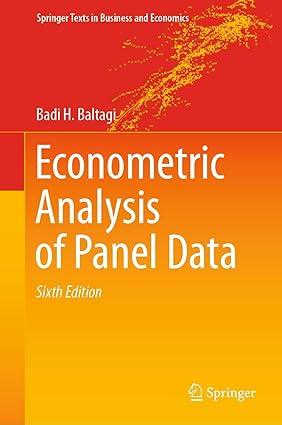A mixed-error component model. This is based on problem 95.1.4 in Econometric Theory by Baltagi and Krmer
Question:
A mixed-error component model. This is based on problem 95.1.4 in Econometric Theory by Baltagi and Krämer (1995). Consider the panel data regression equation with a two-way mixed error component model described by (3.1) where the individual specific effects are assumed to be random, with \(\mu_{i}\) \(\sim\left(0, \sigma_{\mu}^{2}ight)\) and \(u_{i t} \sim\left(0, \sigma_{u}^{2}ight)\) independent of each other and among themselves. The time-specific effects, i.e., the \(\lambda_{t}\) 's are assumed to be fixed parameters to be estimated. In vector form, this can be written as
\[\begin{equation*}y=X \beta+Z_{\lambda} \lambda+w \tag{1}\end{equation*}\]
where \(Z_{\lambda}=\iota_{N} \otimes I_{T}\), and
\[\begin{equation*}w=Z_{\mu} \mu+u \tag{2}\end{equation*}\]
with \(Z_{\mu}=I_{N} \otimes \iota_{T}\). By applying the Frisch-Waugh-Lovell (FWL) theorem, one gets
\[\begin{equation*}Q_{\lambda} y=Q_{\lambda} X \beta+Q_{\lambda} w \tag{3}\end{equation*}\]
where \(Q_{\lambda}=E_{N} \otimes I_{T}\) with \(E_{N}=I_{N}-\bar{J}_{N}\) and \(\bar{J}_{N}=\iota_{N} \iota_{N}^{\prime} / N\). This is the familiar Within time-effects transformation, with the typical element of \(Q_{\lambda} y\) being \(y_{i t}-\bar{y}_{. t}\) and \(\bar{y}_{. t}=\sum_{i=1}^{N} y_{i t} / N\). Let \(\Omega=E\left(w w^{\prime}ight)\), this is the familiar one-way error component variance-covariance matrix given in (2.17).
(a) Show that GLS estimator of \(\beta\) obtained from (1) by premultiplying by \(\Omega^{-1 / 2}\) first and then applying the FWL theorem yields the same estimator as GLS on (3) using the generalized inverse of \(Q_{\lambda} \Omega Q_{\lambda}\). This is a special case of a more general result proved by Fiebig, Bartels and Krämer (1996).
(b) Show that pseudo-GLS on (3) using \(\Omega\) rather than \(Q_{\lambda} \Omega Q_{\lambda}\) for the variance of the disturbances yields the same estimator of \(\beta\) as found in part (a). In general, pseudo-GLS may not be the same as GLS, but Fiebig, Bartels and Krämer (1996) provided a necessary and sufficient condition for this equivalence that is easy to check in this case. In fact, this amounts to checking whether \(X^{\prime} Q_{\lambda} \Omega^{-1} Z_{\lambda}=0\). See solution 95.1.4 in Econometric Theory by Xiong (1996).
For computational purposes, these results imply that one can perform the Within time-effects transformation to wipe out the matrix of time dummies and then do the usual Fuller and Battese (1974) transformation without worrying about the loss in efficiency of not using the proper variance-covariance matrix of the transformed disturbances.
![]()
Step by Step Answer:






